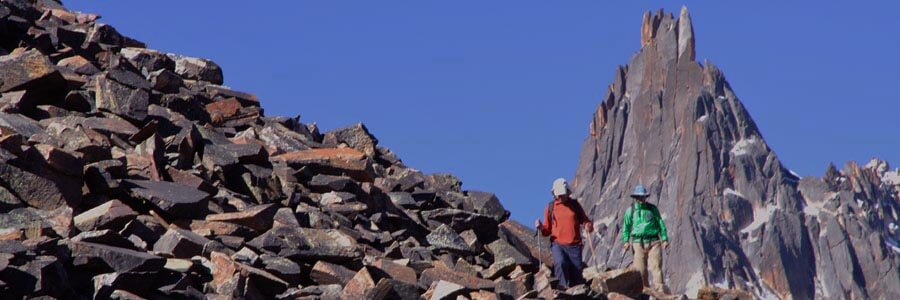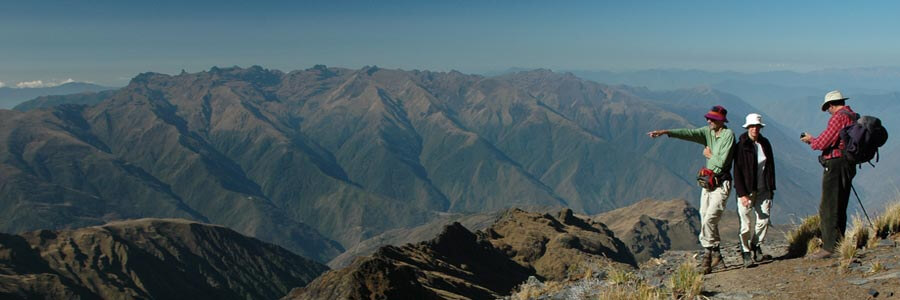 The main features of South America are the Andes mountain ranges. It does not only divides the water basins, the Atlantic and Pacific ones, but also determines dramatically the climate and the weather at both sides of the mountains. The lands in Bolivia range from 200m(656ft) in the lowlands up to 6549m (21,480ft) in the mountains hosting diverse environments from Glaciers to Rainforests; from high Mountain Ranges to Deserts; from Salt Lakes to Cloud forest and from Amazonian or Patagonian Rain Forest to mesothermic valleys.
The main features of South America are the Andes mountain ranges. It does not only divides the water basins, the Atlantic and Pacific ones, but also determines dramatically the climate and the weather at both sides of the mountains. The lands in Bolivia range from 200m(656ft) in the lowlands up to 6549m (21,480ft) in the mountains hosting diverse environments from Glaciers to Rainforests; from high Mountain Ranges to Deserts; from Salt Lakes to Cloud forest and from Amazonian or Patagonian Rain Forest to mesothermic valleys.
The Andes
Please get into Andes Mountain Range for more information about the Andean Mountain range.
Pacific coastline
There is a mainly sandy desertic land no wider than 80km (49.6mi) extended from the Volcanic mountain ranges to the pacific coastline. Areas where rivers provide enough water, develop very productive oasis and the main cities and harbors are placed there.
Good places for fishing and other water sports can be found along the Chilean and Peruvian coasts.
The highlands or Altiplano
The highlands or “Altiplano” (literally high plains) lays between the two montain ranges: the Eastern or Royal Range (of tectonic origin) and the Western or Volcanic range in the bolivian territory and to the western slopes of the volcanic range in the chilean territory. Despite of its name is not all flat, it is actually made up of valleys, rivers beds’, lakes and plains separated by relatively small mountain ranges.
Its average altitude is 4,000m (13,120ft) with its lowest part at Uyuni saltflats 3,660m (12,005ft). and its highest part at Ulla Ulla plains 4,400m (14,432ft). The high Plateau in its approximately 1,000km (621mi) long from North to South; in its wider section is about 200km (124mi) wide.
The "altiplano" in Bolivia houses the cities of La Paz, Oruro, and Potosi; and the inland basin of Titicaca. In the north of Chile, the highlands are located along of the volcanic range that makes border with Bolivia.
Valleys with Mediterranean-like climate lies to the east and southeast of the Altiplano; they house the colonial cities of Cochabamba, Sucre, and Tarija in Bolivia.
One of the most spectacular and unforgettable area of the Altiplano is the colorful, spectrum-like cold desert located in the south called: Lipez in Bolivia and Atacama in Chile. All contained within this desert, you will see awesome Salt Flats, geysers, volcanoes, glaciers, rock and lava canyons, colorful lakes and rivers, and vast, spacious areas which will transport you to a surrealistic world.
Originally called Tunupa salt flats by locals before the foundation of Uyuni Town in 1889, the Uyuni salt flats in Bolivia is a huge 150km (93mi) width concentration of salt is one of the most impressive landscapes in the world. At an altitude of 3,653m (11,981ft) and with very low rain precipitation, 100 to 325 mm per year, it is one of the driest areas in the Bolivian territory. Nevertheless, there is a very delicate and particular ecosystem on their shores and islands (Incahuasi and Pescado are the main ones).
Despite the arid terrain and lack of water, the surrounding deserts have been the cradle of several old, native cultures. On the shores, there are many ancient ruins and archeological remains of the past. Today the most important ethnic groups living in the area are the Urus, the Uruquellas, the Llipi, the Chipayas, and the Aymaras.
Lake Titicaca
Titicaca lake lies on the northern end of the highlands and gets its volume of water from the Andean mountains of Apolobamba and Cordillera Real (its main tributaries are the Suches and the Tiwanacu rivers). Titicaca is the remain of ancient larger lakes that once have occupied most of the highlands.
The microclimate created by the mass of water, offers the best environment for agriculture on the High plateau. That is the possible reason why the Aimaras stayed by the Lake
Titicaca lake is actually formed by two lakes joined by the Tiquina strait; the large lake is called Chucuito, and the smallest one, Wiñaymarca. The lake expands almost 6.642km2 (2.590mi2), and it is 160km (99mi) long by 60km (37mi) width. With a volume of 9 hundred billion cubic meters, it is the largest water mass in the Bolivian highlands. At a height of 3,810m (12,496ft) above sea level Titicaca Lake is the highest “navigable watercourse” in the world. It’s deepest point in at 275m (902ft).
Although this lake has been referred to as “the holy lake of the Incas”, it has also been a cradle of civilization for many ancient cultures. On the shores, beneath the waters, and on the islands of the lake, you can see many ancient ruins and archeological remains of the past. The most important archeological center is Tiwanacu, the ancient capital of the Tiwanacu Empire. 1,500 BD to 1,200 AD.
Surrounded by magnificent vistas, Lake Titicaca is the ideal place to get acclimatized before embarking on a higher altitude adventure. It is not only conveniently located close to La Paz, but Puno in Peru, Copacabana in Bolivia and many other villages by the lake offer a variety of services to the traveler
High altitude cloud forest
Several microclimatic regions constitute the Cloud Forest, also called “Yungas”. The highest part remains cloudy 300 days of the year. This region is located at the eastern side of the mountain ranges of Apolobamba, Cordillera Real, and Quimsa Cruz (Bolivian La Paz and Cochabamba departments). The whole area works as a shield to the humid currents that rise from the Amazonian jungle. Between 1,000m (3,280ft) to 3,500m (11,480ft) there exists a thermal inversion zone. The rising humidity is condensed and a cold mist covers the steep mountains. That has developed a particular ecosystem of cold humid forests. Those subtropical mountain valleys house an abundance of exuberant vegetation and animals.
Amazon basin
The river and the rain forest related to it, are the biggest river basin in the world. The river starts on the mountain range; Hundreds of small streams come down from the glaciers and flow for about 8,000km (4968mi) before reaching the coast of the Atlantic Ocean. Wide as 50km (31mi) on the mouth, creates a very complex delta on the north east of south America. It was called the “fresh water sea” by the Spaniards who discovered it.
Deep canyons are found on the Peruvian tributaries of the Amazon. The lowlands of the north and east of Bolivia are hot, and very humid. Vast savannas and grasslands mainly in Brazil and part of Bolivia, thick jungles and broad rivers, unexplored in some areas cover a great extension of the whole basin.
Dry "Chaco" forest
This region is shared by Bolivia, Paraguay and Argentina. The area is one of the most eroded regions of the continent; mainly bushes, cactuses and small trees compose its vegetation. High temperatures 35°C (95F) to 40°C (104F) and the dry climate make this region one of the most hostile and isolated of the country. The hottest place is Camiri, where the thermometer has recorded up to 52°C (122°F).
Mediterranean climate valleys
Altitudes between 1,500m (4,920ft) and 2,500m (8,200ft). were chosen since the Spaniards time for living, resting and enjoying life, cities like Arequipa, Cochabamba, Sucre, Tarija, with an average day temperature of 22°C (71.6°F) became very good options to spend vacation time. Being very fertile valleys develop the tradition of good eating, garden cities. Those are almost flat valleys surrounded by small mountain ranges up to 4,500m (14,760ft), not to close to the glaciers of the Andes, and provided with plenty of waters from the different basins, en route to the Amazon, or La Plata rivers








